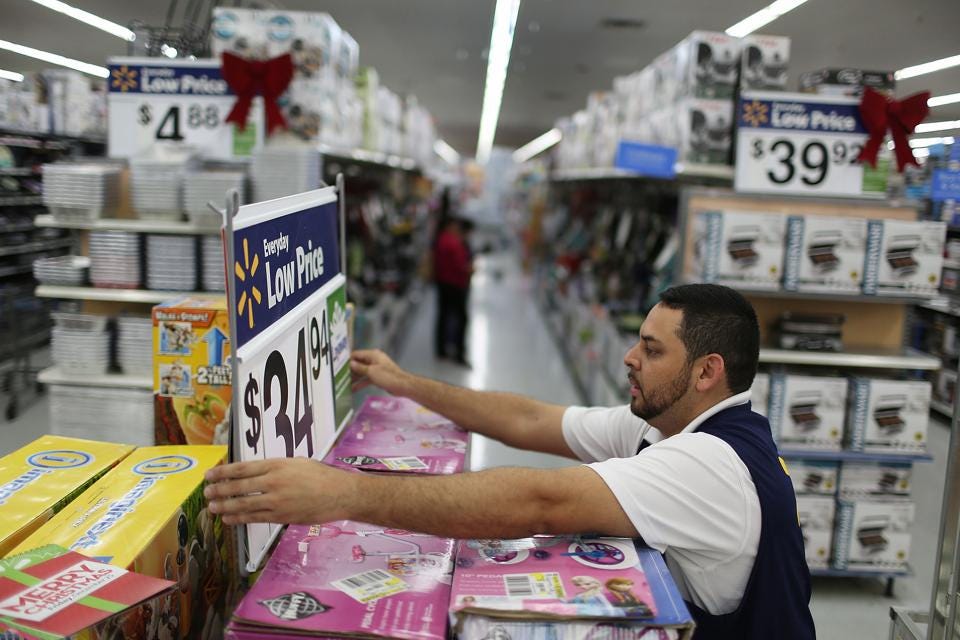
GETTY IMAGES
After the pandemic-led disruption of 2020 and 2021, the retail industry had pinned its hopes on 2022 being a return to something approaching normality.
But with an unstable geopolitical environment and sharp rises in the cost of living, new challenges have arisen alongside those posed by the pandemic.
“The real difference in 2022 is that the cost of living crisis has impacted on consumer demand, especially in the second half of the year,” suggests Andrew Goodacre, CEO of the British Independent Retailers Association (BIRA).
“At the same time, we have seen the costs of running a business increase very sharply – energy costs are 400% more, wages are 10% more and there is still supply chain inflation.”
To survive in 2023 will require close attention to key industry trends that are impacting how the customer will buy, shop and communicate.
Reduced consumer spending

AFP VIA GETTY IMAGES
With high levels of inflation set to continue into 2023, consumers across the globe are feeling the pinch. Consumer confidence has been slipping as rising prices impact everything from the weekly food shop to fuel bills.
Retailers in 2023 have to find the balance between continuing to sell products that are wanted and needed, while recognising that levels of discretionary spending have been hard-hit by the current economic climate.
For many retailers, finding this balance will rely on a number of different tactics, from better stock and range management to communicating in a more personalised way with their customer.
“One way in which retailers can balance the need to maintain profits with a consumer who is becoming ever more focused on value for money would be to simplify the range of products offered,” suggests Boston Consulting Group’s managing director and partner Davide Camisa. “This could include doubling down on own-brands as a means to deliver differentiation, value and price competitiveness.”
He warns against retailers relying heavily on “conventional levers” such as “simply pushing suppliers or reducing staff costs” to maintain operational profit.
“Instead, retailers should look at supply chains to deliver cost savings that do not come at the expense of service, such as better collaboration with suppliers and improved visibility to manage ageing stock.”
Camisa also underlines the importance of successfully communicating with the customer about the products that are of most interest at a specific time. He suggests the use of artificial intelligence (AI) tools to deliver “more personalised and relevant messages, communicating value and choice in the categories that matter to individual consumers.”
Goodacre agrees on value being key for a cost-conscious customer, explaining that: “value is a combination of price, quality and service. Yes there need to be offers and product promotions, but not at the expense of the product quality and service.”
Like Camisa, he notes that the key to driving sales will be in “understanding the needs of customers and creating retail experiences” to help today’s cautious consumer feel comfortable spending.
The rise of resale

GETTY IMAGES
The global apparel resale market grew an estimated 30.1% to $182.4 billion in 2022 according to data and analytics company GlobalData. This rapid growth is set to continue, with a forecast of 85.5% growth between 2022 and 2026, taking global apparel resale spend to $338.4 billion.
With a growing number of platforms offering second-hand goods, and technologies that make resale easier for brands to implement on their own websites, this is one part of the retail industry that is set to flourish in 2023.
Resale ticks two very important boxes. Second-hand shopping is not only an environmentally-friendly option but it also offers lower prices and value for money.
Research by eBay (who recorded a sale of one second hand fashion item per second in 2022) into the motivations of UK adults around buying second-hand showed that their top reasons were: to “get a better deal or to find a bargain” (32%), to “cut back on spending”, and “the rise of the cost of living” (both 31%), followed by a drive to be “more sustainable” (26%).
The growth in resale is fueled by the continued removal of stigma around purchasing second-hand, particularly amongst the younger generation, with Gen Z the most likely to both buy or sell second-hand clothing.
In the UK, eBay’s 2022 sponsorship of hit reality-tv show Love Island was a pivotal moment for resale entering the mainstream. The choice of “pre-loved” fashion for the contestants’ wardrobe was a noticeable departure from previous fast-fashion sponsors.
In 2023, retailers should examine how they can incorporate second-hand or resale into their own models without cannibalizing sales of new goods, or losing money.
If it is not feasible as part of a retailer’s operating model, they should consider that resale is part of the growing awareness and desire for a more circular economy. With sustainability now second-nature for many consumers, items that can be repaired, refilled, renewed or upcycled are increasingly popular and may prove easier to implement for retailers than a resale model.
E-commerce evolves

GETTY IMAGES
E-commerce emerged victorious from the pandemic – in 2021 it was estimated that online sales had accelerated by around 3 years compared to its pre-pandemic trajectory.
In 2022, there was a distinct shift away from e-commerce in many markets. In the UK, there were 10 consecutive months of decline in online sales as a percentage of total retail sales, as shoppers started to embrace stores once more.
With rising ad costs and subsequent higher costs of acquisition, many brands and retailers have found their e-commerce performance challenging to say the least in 2022. All of this begs the question – where now for e-commerce?
For Camisa, this is simply a re-balancing post pandemic, and is clear that there is nothing that suggests that e-commerce is in a terminal decline.
“When retail points of sale re-opened, it was expected to see some of that spend flow back to physical shopping. However, shopping online is generally sticky as a behaviour – so new habits will have been formed, sustaining volumes for the next years,” he shares.
“The fundamentals supporting e-commerce on the demand side are still all there; it is more convenient, provides more choice, service levels are ever rising, in many categories it’s cheaper, and increasingly customer demographics are attuned to online, so I expect to continue seeing long term growth.”
For retailers, this re-balance and potentially slower growth highlights the importance of a hybrid retail strategy. There should be a renewed emphasis on the traction that a strong bricks and mortar presence can bring, particularly from a community engagement aspect.
Goodacre and BIRA highlight that “local shopping is continuing its growth”, and suggests that retailers must “do all they can to engage and communicate with shoppers within 15 miles of their shop”.
Communities or customers?

GETTY IMAGES
In tandem with an overall decline in e-commerce in 2022, there is a sense that the model of simply listing products on websites and expecting them to sell will continue to become less effective in 2023. The online consumer is getting more accustomed to entertainment and commerce blurring, as the creator economy, social commerce and live streaming continue to gain traction.
“Standard e-commerce relies upon static messaging and forces the shopper to put in the effort to find, evaluate, and purchase products that may or may not be the right thing for them,” shares chief product officer of live video commerce platform CommentSold, Andrew Chen.
He argues that “the opportunity that live selling presents in growing, nurturing and fostering a relationship-based community has the potential to significantly alter the retention and revenue metrics that retailers and brands see.
We have many shops that see customers come back 5 times a month when live selling as compared to the average e-commerce only brand and retailer who is lucky to see their shoppers come back even 3 or 4 times a year.”
With acquisition being harder and more expensive every year, Camisa confirms that “retention should be top of mind for retailers in 2023”. Building an engaged community of people who have great affinity for the brand is even more urgent than ever, along with mobilizing loyal customers.
With social commerce and live selling continuing to gain as a proportion of the e-commerce spend, retailers should consider if their e-commerce offering is taking full advantage of new ways to sell and build more engaged and loyal audiences.
A bumpy road ahead
With 2023 set to be in recession for many countries across the globe, it’s clear that retailers will be facing another difficult year.
The key is a blend of careful internal management of stock and range to keep a tight control on operational profit. From a sales perspective, it is vital that retailers understand that their customers want value for money (which may not always mean buying the cheapest item), to shop in a more interactive way, and a community experience that helps them feel part of something bigger.
Despite an overall decrease in discretionary spending, it’s important to remember that customers are still buying. The onus, as has always been true in the retail industry, is on retailers showing what they want to see, when they want to see it.
Original Article Link is found here: www.forbes.com